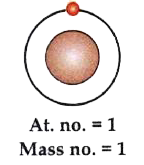Which sub-atomic particle was discovered by
Thomson
Step-by-Step Solution:
1. Introduction to Thomson's Experiment:
- J.J. Thomson conducted an experiment using a cathode ray tube, which is a sealed glass tube from which most of the air has been removed, creating a vacuum.
2. Setup of the Cathode Ray Tube:
- The cathode ray tube consists of two electrodes: a cathode (negative electrode) and an anode (positive electrode). When a high voltage is applied, electrons are emitted from the cathode.
3. Movement of Electrons:
- The electrons move from the cathode towards the anode due to the electric field created by the voltage applied across the electrodes.
4. Observation of Deflection:
- Thomson observed that when the cathode rays (which are streams of electrons) passed through the tube, they were deflected by electric fields created by charged plates placed near the tube.
5. Conclusion of the Experiment:
- Since the rays were deflected away from the negatively charged plate, Thomson concluded that the rays themselves must be negatively charged.
6. Naming the Sub-atomic Particle:
- Based on his observations, Thomson named the negatively charged particles "electrons." This marked the discovery of the electron as a fundamental sub-atomic particle.
Final Answer: The sub-atomic particle discovered by Thomson is the electron.
---
- J.J. Thomson conducted an experiment using a cathode ray tube, which is a sealed glass tube from which most of the air has been removed, creating a vacuum.
- The cathode ray tube consists of two electrodes: a cathode (negative electrode) and an anode (positive electrode). When a high voltage is applied, electrons are emitted from the cathode.
- The electrons move from the cathode towards the anode due to the electric field created by the voltage applied across the electrodes.
- Thomson observed that when the cathode rays (which are streams of electrons) passed through the tube, they were deflected by electric fields created by charged plates placed near the tube.
- Since the rays were deflected away from the negatively charged plate, Thomson concluded that the rays themselves must be negatively charged.
- Based on his observations, Thomson named the negatively charged particles "electrons." This marked the discovery of the electron as a fundamental sub-atomic particle.
Topper's Solved these Questions
- BOOK - ICSECHAPTER - ATOMIC STRUCTURE AND CHEMICAL BONDINGEXERCISE - EXERCISE 4(B)12videos
ATOMIC STRUCTURE AND CHEMICAL BONDING
- BOOK - ICSECHAPTER - ATOMIC STRUCTURE AND CHEMICAL BONDINGEXERCISE - EXERCISE 4(C)54videos
ATOMIC STRUCTURE AND CHEMICAL BONDING
- BOOK - ICSECHAPTER - ATMOSPHERIC POLLUTIONEXERCISE - EXERCISE 8(D)38videos
ATMOSPHERIC POLLUTION
- BOOK - ICSECHAPTER - CHEMICAL CHANGES AND REACTIONSEXERCISE - EXERCISE 2(C)30videos
CHEMICAL CHANGES AND REACTIONS
Similar Questions
Knowledge Check
- Question 1 - Select One
Which atomic particle has negligible mass?
AprotonBelectronCneutronDboth proton and neutron
Describe Thomson's plum pudding model. Which subatomic particle was not present in this model of the atom?
View SolutionWhich part of atom was discovered by Rutherford.
View SolutionThe diagram represents an isotope of hydrogen (H). Answer the following:
Which sub-atomic particles in the 3 isotopes of 'H' are the same.
 View Solution
View SolutionThe number of which subatomic particle is same in case of chlorine atom and chloride ion?
View SolutionThe number of which subatomic particle is same in case of chlorine atom and chloride ion?
View SolutionName the sub-atomic particle whose charge is :
+1View SolutionName the sub-atomic particle whose charge is :
-1View Solution

